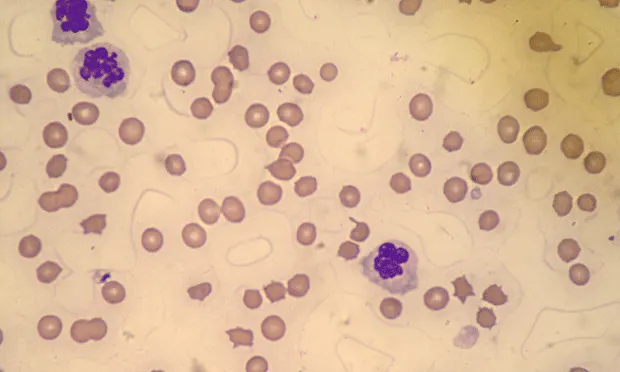Feline Hematologic Disorder

A 10-year-old, neutered male domestic shorthair cat presented to the veterinarian with a history of inappetence, weight loss, polyuria/polydipsia, and occasional vomiting. The signs had been worsening over the past 3 months.
Physical Examination. The cat was mildly to moderately dehydrated on presentation, had a thin body condition, pale-pink mucous membranes, and bilaterally small kidneys noted on abdominal palpation. The vital signs were within normal limits.
Laboratory Analysis. Blood was drawn for a CBC and serum biochemistry analysis. Urine was collected for urinalysis. Further diagnostics were planned, depending on the laboratory results. The samples were sent STAT. Results were available by the early afternoon.
ASK YOURSELF ...
To what body system can the clinical signs be attributed?
Is the disease process acute or chronic?
What is the cause of the anemia?
What is the pathophysiologic mechanism of the anemia?
Where is erythropoietin produced?
Diagnosis: Anemia due to chronic renal failure
Anemia can have detrimental consequences for the veterinary patient, mainly those of dyspnea, decreased activity, exercise intolerance, and lethargy, all of which lessen the quality of life for the animal. Anemia of chronic renal failure is addressed via blood transfusions and human recombinant erythropoietin therapy because the renal disease process is chronic and progressive and not reversible. Since we cannot reverse the disease, we try to minimize the clinical signs in hopes of improving the quality of life of the animal by minimizing the disease manifestations. However, these therapies are not without adverse effects and may be associated with transfusion reactions and the build-up of antibodies against erythropoietin, thereby leading to a worsened anemic state. Consultation with an internal medicine specialist is recommended regarding use of human recombinant erythropoietin.
Did You Answer ...
The azotemia (as evident from the elevated BUN and creatinine), hyperphosphatemia, decreased TCO2, and isosthenuric urine concentration are supportive of underlying renal disease. The azotemia indicates that at least three quarters of the nephrons of the kidney have been damaged. As a result of the decreased functional mass, renal azotemia and hyperphosphatemia develop secondary to the decreased glomerular filtration rate. In addition, the concentrating ability of the kidney is compromised secondary to the decreased response to ADH and decreased medullary interstitial hypertonicity leading to polyuria and hence the isosthenuria. The decreased TCO2 is a reflection of decreased bicarbonate, which is a reflection of metabolic acidosis secondary to decreased removal of uremic acids by the kidney.
The renal disease is chronic as indicated by the mild nonregenerative anemia, hypokalemia, and polyuria. Acute renal failure is not associated with anemia. The anemia may be more severe given that this patient is dehydrated (i.e.,hyperalbuminemia / hyperproteinemia) as a result of vomiting. The anemia is nonregenerative as indicated by the lack of reticulocytosis and polychromasia. The hypokalemia is a result of vomiting and decreased intake.
The anemia is caused by the renal disease. Terms used to describe this type of anemia include anemia of chronic renal failure or less often metabolic anemia (i.e., a metabolic defect that results in anemia).
Decreased functional mass of the kidneys secondary to chronic renal failure leads to a decreased ability to produce erythropoietin in response to hypoxia. Decreased erythropoietin production leads to decreased erythropoiesis by the bone marrow and subsequent anemia of chronic renal failure.
Erythropoietin is produced mainly by the kidneys (renal interstitial cells) and to a lesser extent by the liver.
FELINE HEMATOLOGIC DISORDER • Kimberly J. Caruso
Suggested Reading
Schalm's Veterinary Hematology, 5th ed. Feldman BF, Zinkl JG, Jain NC-Philadelphia: Lippincott, Williams & Wilkins, 2000.Transient and stable transfection of Chinese hamster ovary cells with the recombinant feline erythropoietin gene and expression, purification, and biological activity of feline erythropoietin protein. Baldwin SL, Powell TD, Wonderling RS, et al. Am J Vet Res 64:1465-1471, 2003.